What is Folk Art
Folk art can be performing or visual or a combination of both. Here, I am writing about visual art of Indian folk culture and how I have used that in my garments and sarees. There is no one definition of folk art. In collecting and displaying folk art, the literary sources and protectors of the same i.e. the museum considers various concepts.
- May be decorative or utilitarian.
- May be used every day or reserved for high ceremonies
- Is handmade; it may include handmade elements, as well as new, synthetic, or recycled components
- May be made by and for use within a community of practice or it may be produced for sale as a form of income and empowerment.
- May be learned formally or informally; folk art may also be self-taught.
- Visual folk art can be accompanied by performing folk arts like mono acts, play act, dance, song or poetry.
- Is traditional; it reflects shared cultural aesthetics and social issues. It is recognized that, as traditions are dynamic, traditional folk art may change over time and may include innovations in tradition.
- Of, by, and for the people, inclusive of class, status, culture, community, ethnicity, gender, and religion.
Are Folk & Traditional Art the Same?
Folk and traditional arts can be seen as one component of a broader term, “folklife,” which serves to encompass the idea of folk arts (often perceived to include only material traditions) with other intangible aspects, such as beliefs, customs, legends (immaterial traditions). Folk art and traditional art is an important part of the study of folklore. I will use these terms interchangeably in my writing to discuss traditions that are artfully and skillfully executed and communicated within communities.


How are Folk & Fine Art different?
It is individual (Fine art) vs Community (Traditional or Folk art)
Value and Significance : Fine art is created for its aesthetic value, while folk art is created for its cultural significance.
Purpose : Fine art is often created for public display, while folk art is often created for practical or decorative purposes within a specific community or region.




Art Consumers: Fine art is typically created for a wider audience, such as collectors, galleries, and museums, while folk art is often created for a more local and intimate audience, such as family, friends, or members of a particular community.
Style : Both differ in style. Fine art is often associated with abstract, conceptual, and avant-garde styles. It is created to challenge the viewer’s perception and understanding of the world. It is seen as a reflection of the artist’s inner world and emotions. Folk art, on the other hand, is often associated with traditional, decorative, and functional styles. Folk art can take many forms, including painting, sculpture, textiles, ceramics, and more. It is often created for practical or decorative purposes rather than for its aesthetic value. Folk art is often characterized by its use of bold colors, intricate patterns, and motifs that are unique to a particular culture or region.
In conclusion, fine art and folk art are two different forms of artistic expression that differ in their origins, styles, and purposes. Fine art is often created by professional artists who have received formal training in the techniques and theory of art and is often intended for public display. Folk art, on the other hand, is often created by individuals who have inherited the skills and techniques from previous generations and is often created for more personal and intimate purposes.
India Land of Spectacular Folk Art
One of the most neglected aspects of Indian culture(s) in modern times is its folk art, also known as tribal art or traditional village crafts depending on the community that practices it. What is Indian folk art? Indian Folk Art is a body of art form that originated and/or developed in India. Some of the forms are rock paintings, textiles, sculptures and other a diverse range of surface paintings made by various tribal and cultural groups for religious or social reasons. There are art forms that go back thousands of years, and feature belief in gods, goddesses and powerful spirits. The magic and mystic of India comes alive through these crafts, which have been passed down for centuries. If you’re interested in ancient folklore, mythology and religion, Indian folk art is the perfect realm for you! And of course such vibrant inspiration is the cornerstone of all the folk art I have done in my sarees under collection Samyati (means to travel).
Surviving Folk Art of India
There are about ten most popular Indian folk art that have gained a lot of attention and commercial value. I have used almost all of them in my work. Many sarees were made to order hence I could not list them on my website. The rest are under my collection Samyati. I have starred the folk arts I have used in my collection


Elaboration of Folk Art I Have Used in My Collection
Pichwai Art
Originated in Nathdwara near Udaipur in Rajasthan, India. The main theme of these paintings are Lord Krishna who is depicted as Shrinathji. Other common themes are cows, lotuses, birds, festivals and celebration in Vrindavan.








Pattachitra Art
The word means painting on fabric. It originates in the coastal state of Eastern India called Odisha. These paintings are based on Hindu mythology and specially inspired by Lord Jagannath and Vaishnava sect.The paintings are executed primarily in profile with elongated eyes and features. The picture is of a chitra of Lord Jaganth and his siblings on black silk painted in typical Odisha Pattachitra style. The picture is only of the pallav. The saree was done on order for a client. We can recreate similar paintings on sarees/dupattas/upholstery on order. Please Contact Us.


Gond Art
Gond painting is a famous folk art of the Gond tribal community of central India –mainly in the Patangarh Village in Dindori district of Madhya Pradesh. It is done to preserve and communicate the culture of the Gond tribal community. Gond tribal art includes folk dances, folk songs, and Gond paintings. The Gond tribe is one of the largest tribal communities in India living in Madhya Pradesh, Telangana, Bihar, Maharashtra, Odisha, and Andhra Pradesh.The Gond tribe believes that seeing a good image brings lots of good luck to them. Hence Gond tribal paintings are made on various festivals, rituals, and ceremonies such as Diwali, Karva Chauth, Nag Panchami, birth, marriage, etc. The themes and motifs of Gond painting are drawn from local flora and fauna, deities and urban culture.
I love Gond art for it’s vibrancy. It just seems there is a luminescence bursting out of darkness, has a spiritual symbolism in my mind. I have used all the typical Gond themes alongside my own which I executed in this style. View them under my collection Samyati.
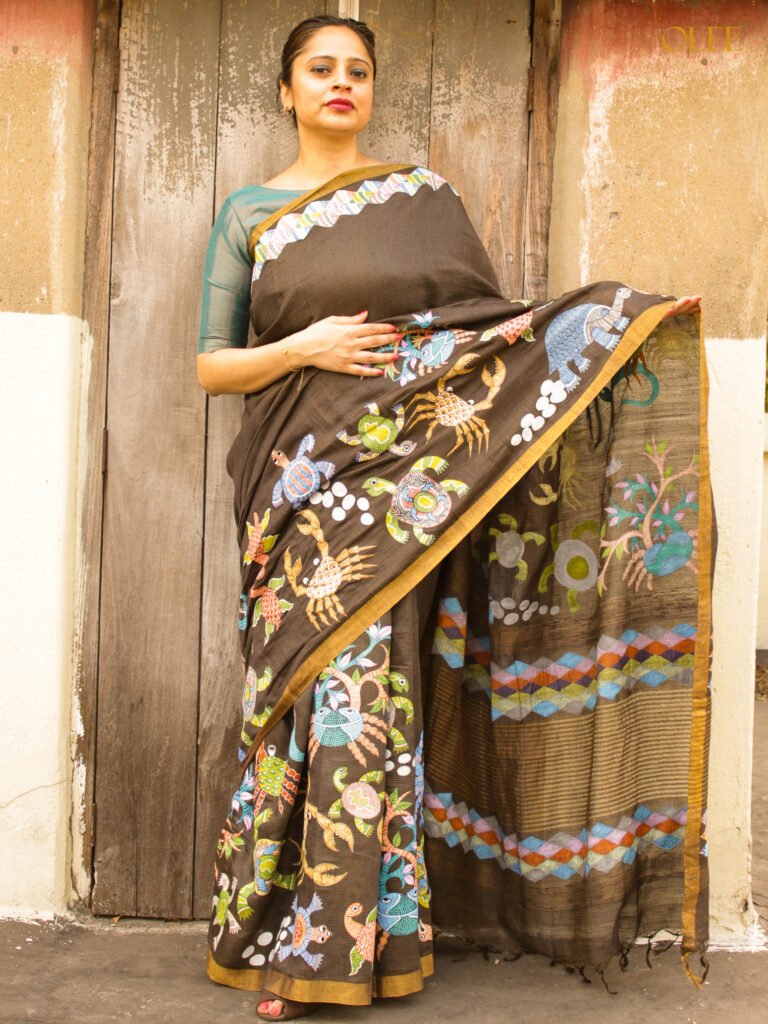





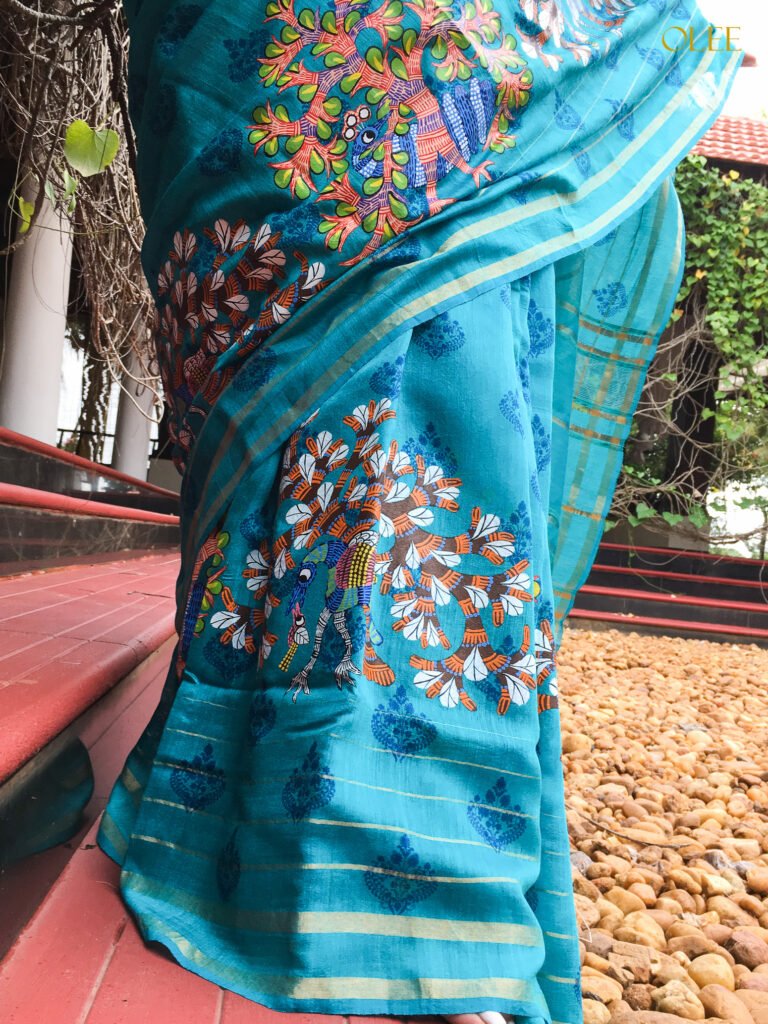

Madhubani Art
One of the oldest folk art of India. It is practiced in the Mithila region of Bihar and Nepal; it is called Mithila or Madhubani art. Some of the initial references to the Madhubani painting can be found in the Hindu epic Ramayana when King Janaka, Sita’s father, asks his painters to create Madhubani paintings for his daughter’s wedding. The knowledge was passed down from generation to generation and the paintings began to adorn the houses of the region. The overall look of themadhubani canvases is voluptuous bright strokes and formation. There are no empty spaces in the Madhubani art canvass. All empty places are filled up with patterns. Usually the border of these paintings is a double line in black.The common themes are social occasions like festivals, religious rituals, weddings, Hindu deities and the sun and moon.
Madhubani paintings have a whole
different appeal. They are very popular with most art lovers and I have no
problem finding patrons of hand painted clothes/sarees in this style.
Few of the art work I have done are intricate black outlines inscribing elaborate celebrations on silk sarees. View them under my collection Samyati.


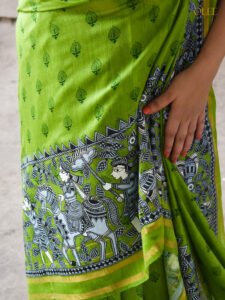





Kalamkari Art
Derives its name from the word ‘kalam,’ which means pen, ‘Kalamkari’ refers to a particular, intricate style of hand-painting on cloth. Kalamkari originated in the modern-day states of Andhra Pradesh and Telangana several hundred years ago. It was first used to portray scenes from sacred texts such as the Mahabharata, Ramayana and Bhagavatam. These paintings were often displayed as decorative backdrops in temples, depicting the stories of deities. Original Kalamkari paintings use colours extracted from only natural elements.
I have produced paintings in Kalamkari style on sarees. I have used acrylic paints and not natural vegetable dyes to keep a check on the cost and time. View them under my collection Samyati. Gilhari is a Kalamkari hand painted saree with myinterpretation of Tree of Life and squirrels scurrying amongst the branches. Kasturi is about Musk Deer.








warli Art
Warli art is an ancient Indian folk art, tradition of painting of a tribe residing in the hills of Maharashtra called Warli. Initially the women of the tribe decorated the walls and floors of their mud huts with Warli paintings. Warli painting is very simple and rudimentary with basic shapes like circles, triangle, squares and lines. Yet there is a spectacular synergy of
these basic shapes to create exceptional dignity of aesthetics.These rudimentary paintings are made using a set of basic geometric shapes-circle, triangle, and a square. These shapes are considered to be symbolic of different elements found in nature – the sun,moon, mountains and humans.
The sarees in the pictures were commissioned on order. We can recreate similar paintings on sarees/dupattas/upholstery on order. See Contact Us.
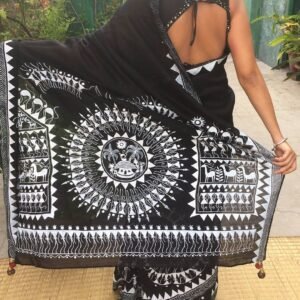



Miniature Art
The earliest Miniature paintings in India can be traced back to the 7th century AD, when they flourished under the patronage of the Palas of Bengal. Mughal paintings are very rich in colours, meticulously painted and attention to the minutest detail. The painting is a true depiction of the opulence of the times.They were originally done on small and delicate palm leaves.Unlike Mughal miniature art, which depicted royal life, Rajasthani miniatures centered around the love stories of Lord Krishna and the mythological literature of Ramayana and Mahabharata, created as manuscripts and decorations on the walls of havelis and forts.
The saree in the picture was commissioned on order. We can recreate similar paintings on sarees or dupattas on order. See Contact Us.










Bengal Patachitra Art
Bengal’s performing art of social and religious story-telling through songs and paintings is called ‘Patachitra’. In a patachitra, each section was referred to as a pata, and the travelling patuas would roll open the scrolls singing one pata at a time.This process of combining art with narratives and songs, that gave Patachitra it’s unique identity, is seen in West Bengal, Odisha, and in some parts of Bihar and Jharkhand. Their audience the villagers were mostly illiterate peasant folks saw and learned about their religious and cultural practices in an enchanting and traditional audio visual media.The Bengal patachitra can be categorized into various types based on their differences in style, such as, Durga Pat, Chalchitra, Medinipur Patachitra, Kalighat Patachitra, and the tribal Patachitras.
The sarees in the pictures were commissioned on order. We can recreate similar paintings on sarees/dupattas/upholsteries on order. See Contact Us.








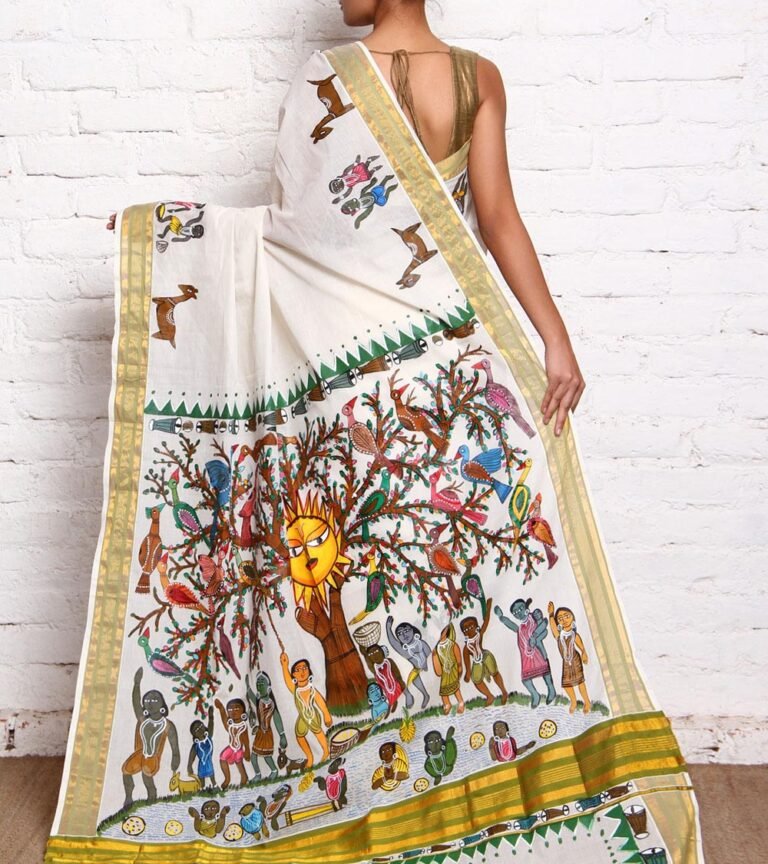

Olee & Indian Folk Art
I have spent a lot of time with tribal artists, understanding their culture, traditions, motivations and struggles. Like a child each saree has its own destiny and I cannot predict eventually who will adopt the piece. But creating them has been a fulfilling journey and adds generously to my knowledge reserves of India and her ocean of heritage. For every piece, we: along with me, my painters, textile experts (who advice on suitable fabric texture and composition for the painting or print) and sometimes my clients for whom I have created the pieces are involved from inception to finish. It is a deeply consuming process and equally rewarding. I have interacted with painters from a wide part of India belonging to different regions that pioneer the respective art forms. Experiencing their unlimited reserves of skills, aesthetics and knowledge of our traditions and culture has been a humbling experience in the very least. One of my biggest vision for Olee is to work with handmade and handloom and share my experience and knowledge of the rich Indian heritage with patrons; who appreciate the rich weaves of our country that seamlessly intermingle threads of music, dance, folk lore , folk art laced and bear the excellence of our very own craftsmen. In the world of fast fashion and power looms, they deserve a salute to their commitment and skills.
folk art map of india
Below is the folk art map of India. I have circled the ones, I have used in my collection so far.
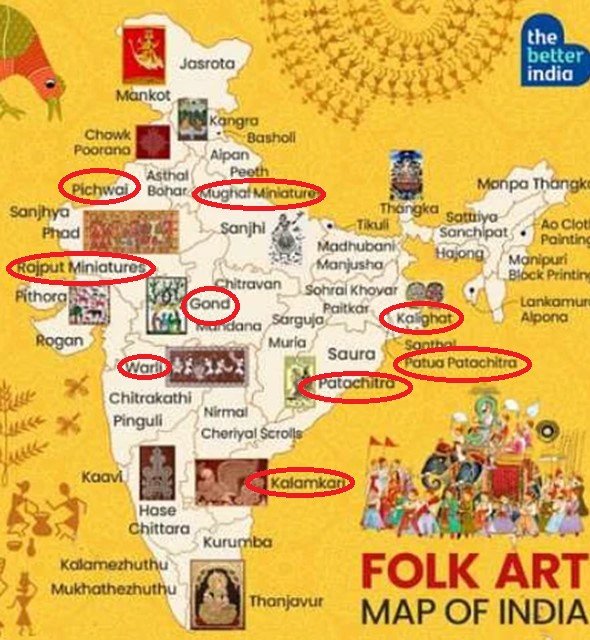

folk art map of india
|
State/Union Territory |
Folk art from |
|
Leh Ladhakh , Sikkim , Arunachal Pradesh , |
Tibetan & Thangka Art |
|
Punjab |
Mudwall Painting or Chowk Poorana |
|
Haryana |
Rajput School Of Wall Painting , Kalayat and Kaithal, Rohtak Painting |
|
Nagaland |
Nagaland Cloth Painting |
|
Goa |
Goal Folk Art |
|
Karnataka |
Chittara , Ganjifa art Mysore Style Samavasaran |
|
Aasam |
Assamese Scroll Paintings, Assam Folk Paintings |
|
Jammu and Kashmir |
Basholi |
|
Maharashtra |
Warli , Pinguli , Chitrakathi |
|
Andhra Pradesh |
Kalamkari , Tirupati School of Painting Adiyasi Kolam Painting |
|
Telangana |
Cheriyal Scroll art , nirmal arts , Deccani Painting , Kalamkari |
|
Odisha |
Pattachitra , Chitrapothi , Mural Paintings , Saura , Santha |
|
Bihar |
Madhubani , Mica , Santhal , Manjusha , Patna Qalam or Patana School of Painting |
|
Chattisgarh |
Dokra , Pithora , Godhna |
|
Gujrat |
Mata ni Pachedi , Gujrat Folk , Rathwa , Rogan , Miniature art , Pithora |
|
Madhya Pradesh |
Gond , Bhill , Mandana , Sanjihi , Thapa , Pithora |
|
Bengal |
Patua , Chaksudun , Terracotta Plate Work , Folk Painting from Midnapore , Kalighat Painting , Bengal Scroll |
|
Jharkhand |
Dhokra art , Paitkar , Jadopatia Paintings , Sohraj art , Kohver art , Ganju art , Rana , Teli & Prajapati art , Kurmi art , Mudas art , Turi art , Birhor art ,Bhuiya art , Ghatwal art |
|
Rajasthan |
Miniature art , Phad , Pichwai , Meenakari , Jaipurart ,Marwar art , Mewar art , Bikaneri art , Bundi & Kota , Kishangarh , Dhenu , Kavad , Jogi |

